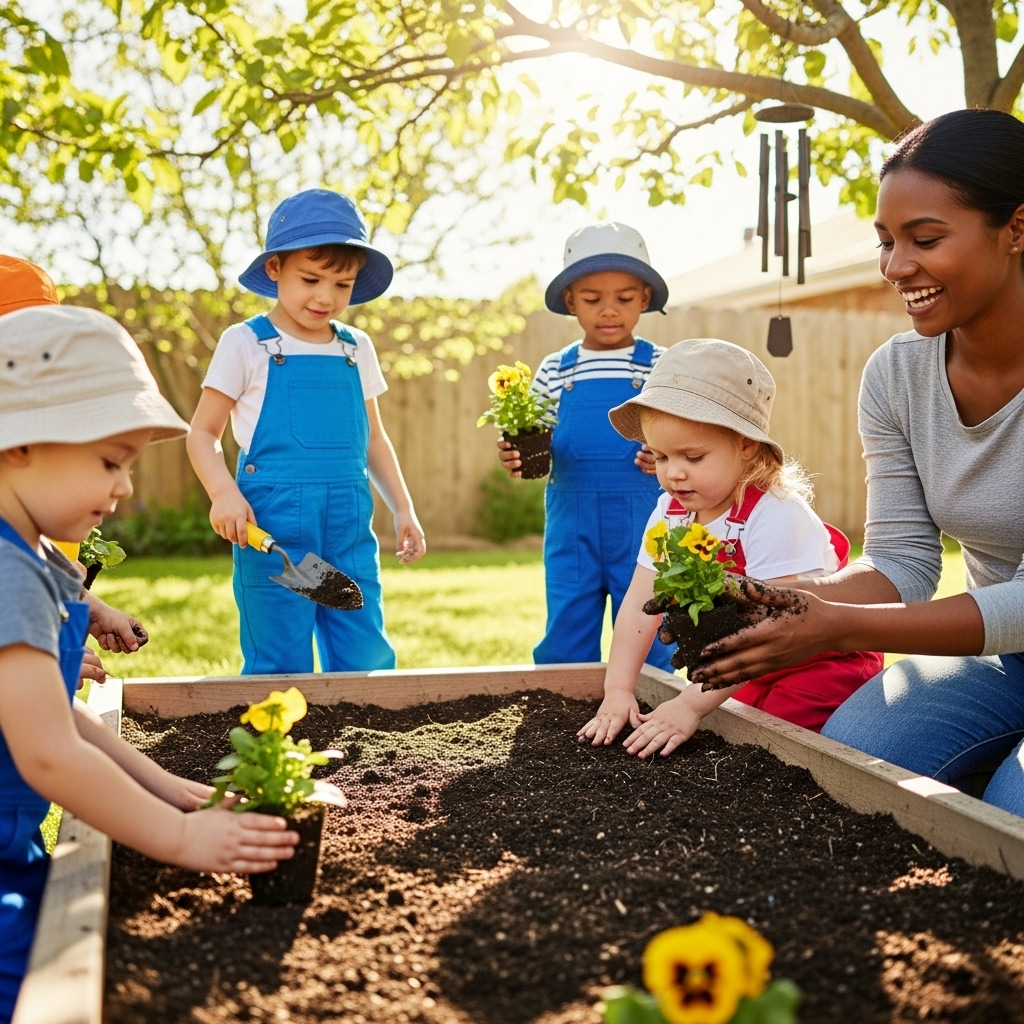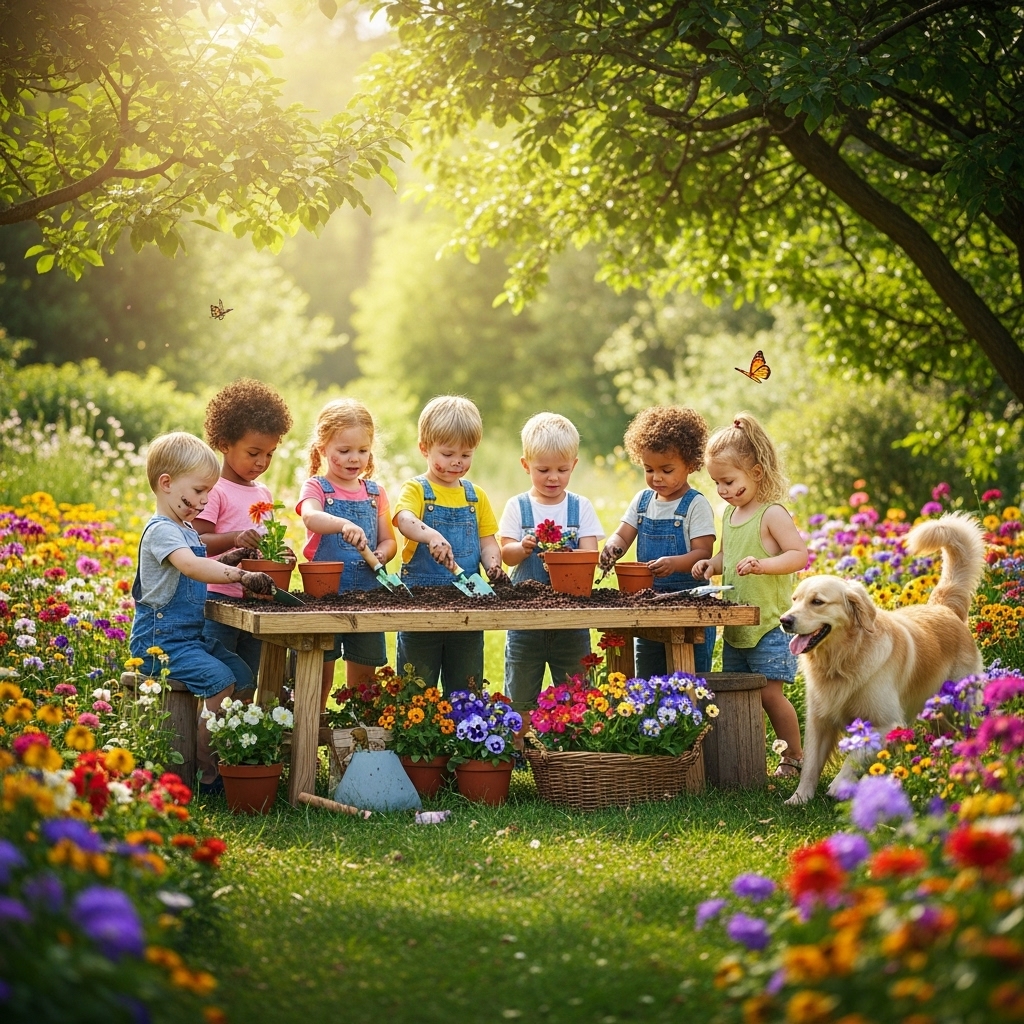Gardening with kids is a delightful way to spark their curiosity about nature! This flower planting activity is not only fun but also easy enough for our little ones to participate in and enjoy. Let’s dig into the joy of gardening together!
Getting Started: Preparing for the Flower Planting Activity

As a parent, I’ve found that involving my children in hands-on activities fosters their growth and curiosity. Gardening is one of those magical activities that combines education with fun, and it’s perfect for preschoolers. With a little preparation and the right approach, I can turn our backyard into a blossoming classroom. Here’s how I do it:
Choosing the Right Flowers
The first step I take is selecting the right flowers to plant. For little hands and minds, I prefer to choose seeds or seedlings that are easy to manage and quick to grow. Some of my favorites include sunflowers, marigolds, and zinnias. These flowers are not only vibrant and cheerful, but they also tend to thrive in various conditions, which makes them forgiving for young gardeners. I also love how sunflowers can grow tall, making it a delightful experience for my kids to watch them reach for the sky!
Gathering Supplies
Next, I gather the necessary supplies, ensuring it’s engaging and safe for my little ones. Here’s what I usually collect:
- Seeds or seedlings
- Potting soil or garden soil
- Small pots or a designated garden area
- Watering can or spray bottle
- Child-sized gardening tools (like trowels and gloves)
- Labels or markers for plant identification
Involving my kids in the preparation phase is crucial. I let them help gather the supplies, making it a fun scavenger hunt. They love being part of the process! It also teaches them responsibility and planning.
Preparing the Planting Area
Once we have everything, I designate a planting area, whether it’s a small patch in the garden or individual pots. I like to explain to my children the importance of sunlight and drainage for our flowers. We often discuss why some plants need more sun than others, and I encourage them to observe the sunlight patterns in our yard. This turns the activity into an interactive learning experience!
With my kids’ help, we loosen the soil by turning it over with small trowels. They enjoy feeling the texture of the soil and often ask questions about the bugs or worms we find. I take this opportunity to teach them about the ecosystem and how important it is to maintain balance in nature.
Planting the Seeds or Seedlings
Now comes the exciting part—planting! I demonstrate how to create small holes in the soil, whether for seeds or seedlings, and show my kids how deep they should go. I encourage them to place the seeds or seedlings into the holes gently. They love the feeling of planting something and the anticipation of seeing it grow. I often say, “We are giving life to these flowers!” This phrase ignites their imaginations and excitement about the project.
After planting, I walk them through covering the seeds or roots with soil. Sometimes, I even make it a playful game where we pretend to be “little gardeners,” taking care of our precious plants. This engagement helps them understand the nurturing aspect of gardening, which is just as important as the planting itself.
Watering and Caring for Our Plants
With everything planted, it’s crucial to teach my kids about the next steps: watering and caring for our flowers. I let them take turns using the watering can or spray bottle, making sure not to overwater. We talk about how plants need water but can drown if they get too much. This simple lesson helps instill a sense of responsibility and care in them.
Every day, we check on our plants together. I encourage them to observe changes—like new leaves or growth—documenting these moments with drawings or photographs. This not only enhances their observational skills but also keeps them excited about the progress of their flowers.
Adding Creativity: Labels and Decorations
To make the activity even more enjoyable, I involve my kids in labeling their plants. We use popsicle sticks, stones, or even recycled materials to create colorful labels for each flower. They scribble names on the labels, and I encourage them to express their creativity. This adds a personal touch to our gardening project and helps them learn the names of different flowers.
Sometimes, we decorate the pots with paint or stickers, allowing their artistic expressions to shine. This activity not only beautifies our garden but also strengthens their connection to the flowers they planted.
By the end of our planting session, I see the joy in their faces as they realize they’ve created something beautiful. It’s a delightful experience that fosters not only an appreciation for nature but also teamwork and creativity. As we continue this gardening journey, I can’t wait to see how much they learn and grow alongside their flowers!
Exploring the Science Behind Gardening

As we venture deeper into our gardening journey, I’ve discovered that there’s a wealth of knowledge to explore beyond the hands-on activities. Gardening offers a fantastic opportunity to delve into the science behind plant growth, ecosystems, and environmental stewardship. I find that discussing these topics with my kids not only enriches their understanding but also ignites a genuine curiosity about the world around them.
Understanding Plant Life Cycles
One of the first scientific concepts I introduce to my children is the life cycle of plants. We talk about how seeds germinate, grow into seedlings, and eventually blossom into beautiful flowers. Using visuals like diagrams or even time-lapse videos of plants growing can captivate their attention. I love to ask them questions, such as “What do you think happens beneath the soil?” This sparks engaging conversations about roots, nutrients, and the journey of plants as they develop.
We also create a simple chart to track the growth stages of our flowers. Every week, we measure their height and note any changes. This activity not only reinforces the concept of growth but also introduces them to basic data collection and observation skills. It’s amazing to see their excitement when they notice a new leaf or a budding flower!
The Role of Pollinators
As our flowers begin to bloom, I take the opportunity to discuss the vital role of pollinators in our ecosystem. We talk about bees, butterflies, and even hummingbirds, explaining how they help plants reproduce. I find it fascinating to educate my kids on how some flowers are specifically designed to attract these creatures, and we often set up a small observation area where they can watch pollinators in action.
To make this learning experience even more engaging, we sometimes create simple bee hotels or butterfly feeders to attract these essential helpers to our garden. My children love the idea of providing a safe space for these creatures, and it cultivates their understanding of biodiversity and the importance of every organism in the ecosystem.
Soil Science and Composting
Another enriching aspect of our gardening experience revolves around soil and its importance. I explain to my kids that soil is a living entity filled with nutrients that help our plants thrive. Together, we dig deeper into the composition of soil, discussing the different layers and what makes healthy soil. This is where I introduce them to the concept of composting.
We set up a small compost bin in our backyard where we can dispose of kitchen scraps and yard waste. I love that this activity not only teaches them about recycling but also highlights the natural process of decomposition. My kids are often surprised to learn how kitchen scraps can turn into rich compost that nourishes our plants. Every time we add to the compost bin, we discuss what items are suitable and why they are beneficial to our garden.
Weather and Its Impact on Gardening
The weather plays a significant role in our gardening adventures, and I find it essential to explore this topic with my kids. We discuss how sunshine, rain, temperature, and even wind affect plant growth. I encourage them to observe the weather patterns over the seasons, noting how certain flowers thrive in specific conditions.
To enhance their understanding, we create a simple weather journal together. Each day, we record the weather and any changes we notice in our garden. This practice not only helps them learn about meteorology but also fosters a sense of responsibility as they take note of their surroundings. It’s rewarding to see them connect how a sunny day can bring out vibrant blooms while cloudy days might slow growth.
Emphasizing Sustainability and Environmental Care
As we explore the science of gardening, I make it a point to emphasize sustainability and environmental care. I share with my kids the importance of using natural pest control methods instead of chemicals, as well as how to practice water conservation. We discuss the significance of planting native species and how they support local wildlife, making our garden a more harmonious part of the ecosystem.
We also participate in community gardening events or local cleanup days, which allows my children to see firsthand the impact of caring for our environment. These experiences instill a sense of stewardship and responsibility, reminding them that every small action counts toward preserving our planet.
Celebrating Our Gardening Journey
As the flowers bloom and our garden flourishes, I make sure to celebrate our successes together. We organize a small garden party or picnic where we can admire our hard work. This event becomes a highlight for my kids, allowing them to showcase their plants to family and friends. It’s a wonderful way to reflect on all the learning and growth we’ve experienced together.
Through gardening, I’ve witnessed my children develop a deep appreciation for nature, cultivate responsibility, and foster creativity. Each moment we spend in the garden is a precious opportunity for learning, bonding, and nurturing their growth as young stewards of the earth. As we continue on this gardening journey, I’m excited to see where our adventures will take us next!
Final Thoughts
Gardening with my kids has been a transformative experience for our family. It’s more than just planting flowers; it’s about nurturing curiosity, fostering a love for nature, and creating lasting memories. I encourage every parent to embrace the joys of gardening with their children. It’s an incredible way to connect, learn, and grow together.
